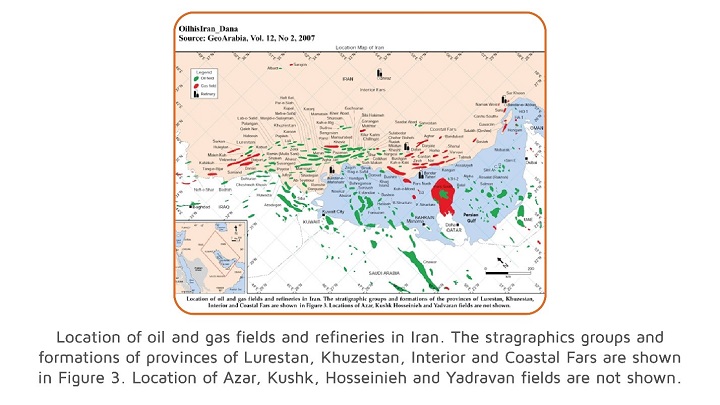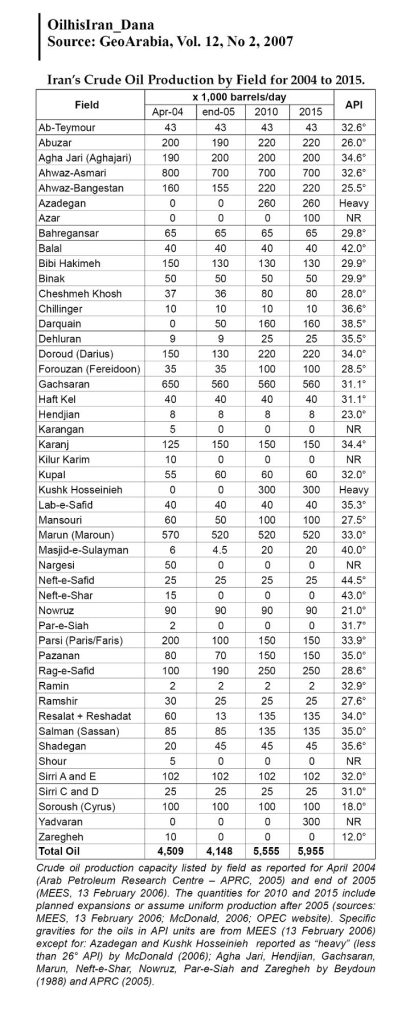The stability and amount of oil production depends on two factors: technology and the condition of the oil reserve. The most important thing is to identify the behavior of the reservoir the identification of which is the responsibility of oil geologists. The use of oil reservoirs in Iran has been influenced by technology and the increase of oil revenues. This situation has changed since the 1979 revolution. Here is a part of Mojahed Hosseini’s article published in Geo-Arabia magazine Vol. 12 in 2007 with a map and two tables.
Crude oil production increased systematically from the low amount of 27 Kb/d in 1952 to the peak of 6.02 Mb/d in 1974. Production increased 6-fold from 1959 to 1974, rising by about 1.0 Mb/d every 2–3 years, and remained at a high rate until the revolution of December 1979 and the nationalization of the industry, when it fell to 3.17 Mb/d. The declaration of the Iran-Iraq War in September 1980, less than a year after the 1979 Revolution, had a further impact, with the production dropping to 1.57 Mb/d. The war damaged refineries, terminals, petrochemical complexes and, in particular, the main shipping facility on Khark Island. Exports came to a near standstill by September 1980 and by the end of the year had recovered to no more than 350 Kb/d, compared to nearly 4.0 Mb/d in 1974. But production rose in 1981 to 1.33 Mb/d with exports ranging between 600 Kb/d to 1.3 Mb/d. The history of production from 1974 to 1978 shows that the decline commenced after 1974 and was not entirely due to the events of 1979 and 1980. In 1975 it fell by 672 Kb/d to 5.35 Mb/d. It reached a second peak of 5.88 Mb/d in 1976, before declining to 5.24 Mb/d in 1978. This decline occurred despite a sharp rise in oil price from $2.50 to $10.0 per barrel in 1974 and $40 per barrel in 1979, and despite the Government’s desire to increase production. It shows that production from Bangestan reservoir in Lali field, which went on stream in 1948 and was producing 15 Kb/d in 1959, had ceased by 1973. Production from another three giant fields systematically declined between 1959 and 1978: Haft Kel (150 to 4 Kb/d; IOIP = 8.6 Gb), Masjid-e-Sulayman (45 to 8 Kb/d; IOIP = 6.6 Gb) and Neft-e-Safid (54 to 30 Kb/d; IOIP = 3.0 Gb).
Tables 2 and 3 provide an overview of the distribution of oil and condensate by field and reservoir, indicating a total crude oil in-place (IOIP) of about 600 Gb and condensate in-place (ICP) of about 32 Gb. Asmari and Bangestan reservoirs are found in many fields and account for about 260 Gb and 150 Gb, respectively, representing approximately 43% and 25% of initial-oil-in-place. The main reservoirs are briefly discussed in the following sections.
The Asmari Formation encompasses the most prolific and productive reservoir, holding some 43% of IOIP. Table 4 shows the relative importance of Asmari reservoir in those fields having an IOIP of more than one billion barrels. The four supergiant fields, namely Gachsaran, Marun, Agha Jari and Ahvaz, contain about 152 Gb, or 60% of Asmari reservoired IOIP, and about 25% of the country’s total. Nine more giant fields, each containing more than 5 Gb initial oil-in-place, represent another 30% of Asmari reservoired IOIP; namely Bibi Hakimeh, Parsi, Rag-e-Safid, Ramin, Karanj, Haft Kel, Pazanan, Masjid-e-Sulayman and Kupal.
The recovery factor (RF = EURR/IOIP) for Asmari reservoir varies from 64% in Ahvaz field to 8% in Kilur field (Table 4). Very high recovery factors are also noted in Agha Jari (58% including Bangestan reservoir), Marun and Mansouri (47%) fields. High recovery factors (30–40%) characterize Cheshmeh-Khosh, Gachsaran, Lab-e-Safid, Parsi and Ramshir. Recovery factors of less than 30% are found in Abuzar, Ghaleh Nar, Haft Kel, Masjid-e-Sulayman and Pazanan fields.
According to Alsharhan and Nairn (1997), the Asmari Formation in Khuzestan Province consists of wackestone and packstone, ranging in thickness from 320–488 m (1,050–1,600 ft), of which 10–280 m (33–918 ft) comprises effective reservoirs. Evaporites of the Gachsaran Formation provide an overlying seal. The reservoir generally has a low primary porosity of less than 5%; but as much as 25% secondary porosity due to fracturing. The average permeability is about 10 mD but can reach 100 mD in fractured zones. To the north of the Gulf, the Ahvaz Formation contains sandstone layers that significantly improve the porosity, permeability and recovery factor. The improvement is well illustrated by the very high recovery factor of 64% for Asmari sandy reservoir in Ahvaz field (Table 4), which is made up of eight sandstone and six carbonate layers (Schlumberger, 2003). The production (700–800 Kb/d, Table 1) comes mainly from 200 wells producing from the Asmari sandstone layers, which have a high porosity and permeability and act as conduits for fluid flow. The Asmari carbonates, by contrast, have low porosity and permeability and act as barriers. Asmari reservoir in Marun field also contains sandstone layers (Beydoun, 1988) and has a high recovery factor of 47%.
The second most prolific and productive zone is the Cretaceous Bangestan Reservoir (Table 2). It is found in two formations that sometimes contain separate reservoirs. The older Sarvak reservoir is found in the Albian-Turonian Sarvak Formation. The younger Ilam reservoir is found in the Santonian-Campanian Ilam Formation. A number of confusing issues of nomenclature are to be noted. Bangestan Reservoir should not be confused with the Albian-Campanian Bangestan Group consisting of the Kazhdumi, Sarvak, Surgah and Ilam formations (Figure 3). In some fields, the Kazhdumi Formation consists of sandstones and is separately reported as a reservoir by this name although it is part of the Bangestan Group. In other fields, Kazhdumi is replaced by the correlative the Burgan reservoir of Iraq and Kuwait, the Khafji and Safaniya reservoirs of Saudi Arabia and the Nahr Umr (Nahr-e-Umr) reservoir of Oman (Figure 4). Bangestan reservoir contains large amounts of initial-oil-in-place in many of the fields listed in Table 2. In general, the recovery factors range between 20% and 30%. Ahvaz field has the largest amount of initial-oil-in-place at about 37.6 Gb, with a recovery factor of 20%, being followed by Azadegan (22.3 Bb, 18.4%), Mansouri (18.5 Bb, 17.6%) and Ab-Teymour (9.0 Gb, 29%). But Bangestan reservoir is not as prolific as Asmari reservoir in the supergiant Agha Jari and Marun fields, containing about 2.3 Gb and 3.0 Gb, respectively. According to Alsharhan and Nairn (1997), Bangestan reservoir consists of massive, shallow marine limestones. The gross and net thickness range of the reservoir are 220–980 m (722–3,214 ft) and 70–630 m (230–2,066 ft). Bangestan reservoir has a porosity range of 4–15%. The older Sarvak Formation consists of a lower argillaceous limestone, grading upwards into massive microporous limestone and nodular chert. The porosity of between 7–14% is due to fissuring, and the gross and net thickness range from 24–790 m (79–2,591 ft) and 5–285 m (16–935 ft). Ilam Formation consists of argillaceous limestone and shale with a porosity of 9–20%, also due to fissuring, while the gross and net thicknesses range from 25–170 m (82–558 ft) and about 110 m (361 ft), respectively.
The youngest Cretaceous reservoir in Iran is found in the Maastrichtian Gurpi Formation, and it is developed as a separate reservoir in, for example, Azadegan field. Below the Gurpi Formation, the undifferentitated Khami reservoir takes its name after the Jurassic Lower Cretaceous Khami Group. In most fields however, the individual reservoirs of this age are cited separately (in alphabetical order: Arab, Dariyan or Darivan, Fahliyan, Gadvan, Hith, Manifa, Ratawi, Shu’aiba, Surmeh, Thamama and Yamama). The so-called “Dictioconous” reservoir of Nowruz field has not been described in the literature but is probably of Early Cretaceous age. Khalij reservoir, which contains condensate reserves in Agha Jari and Milaton fields, has also not been described in the literature but is probably of middle Cretaceous age. Most of the gas and condensate reserves (Table 3) are found in the Permian-Triassic Deh Ram (Dehram) Group. In ascending order, it comprises the Faraghan clastics and Dalan carbonates/evaporites of the Permian, and the Kangan carbonates of the Lower Triassic. The Upper Dalan Member (above the middle Nar Anhydrite Member) and Kangan Formation represent the most significant reservoirs for non-associated gas and condensate, being correlative with Khuff A, B and C reservoirs of Saudi Arabia (Alsharhan, 2006; Insalaco et al., 2006). In some fields, the Triassic Dashtak Formation is shown to contain gas and condensates.




We Answer Your Questions